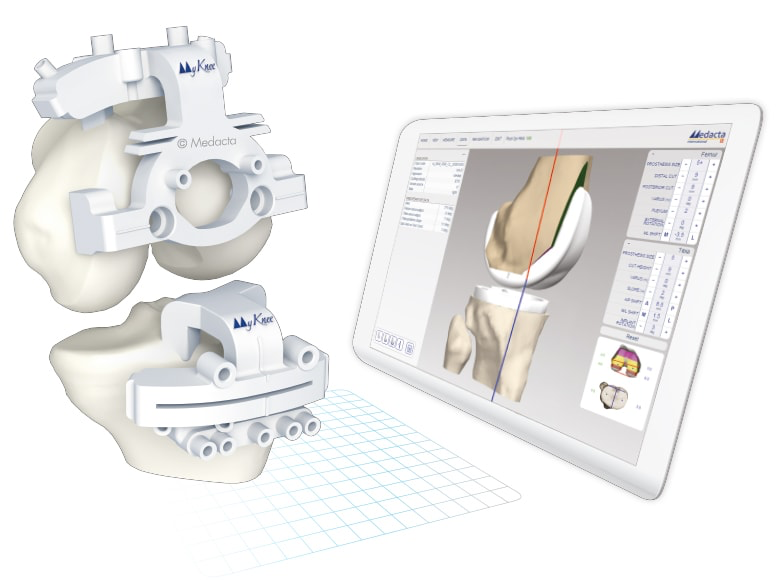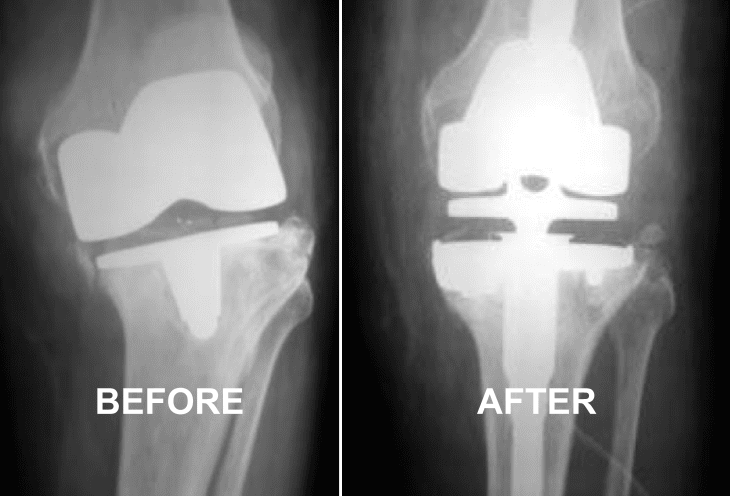Revision Total Knee Replacement
What is Revision Total Knee Replacement?
Revision Total Knee Replacement, also known as revision knee arthroplasty, is a surgical procedure performed to replace a previous knee replacement implant that has worn out, loosened, or failed due to various reasons, such as infection, implant breakage, bone loss, or instability.
It is a more complicated and challenging surgery than the initial knee replacement, as it involves removing the old implant and replacing it with a new one while restoring the damaged bone and soft tissues.
Who is Suitable for Revision Total Knee Replacement?
Not all patients with a primary knee replacement require revision surgery. However, certain factors may indicate the need for Revision Total Knee Replacement, such as persistent pain, stiffness, swelling, instability, or loss of function in the knee joint. Revision Total Knee Replacement may be suitable for patients who have:
- Experienced a mechanical failure of the previous implant, such as implant loosening, dislocation, or fracture
- Developed infection in the knee joint or surrounding tissues
- Suffered significant bone loss or osteolysis, which may require bone grafting or metallic wedges/cones for augmentation
- Experienced ligament or tendon damage, which may require reconstruction
- Developed a significant deformity, such as a varus or valgus malalignment, that affects the knee's stability and range of motion
Benefits of Revision Total Knee Replacement
- Improved joint function: Revision Total Knee Replacement can restore proper joint alignment, stability, and range of motion, resulting in reduced pain, stiffness, and swelling and improved mobility and function.
- Long-term implant survival: With advancements in implant design, materials, and surgical techniques, Revision Total Knee Replacement can provide long-term implant survival rates similar to those of primary knee replacement.
- Reduced risk of complications: Revision Total Knee Replacement is a more challenging surgery than primary knee replacement, and it carries a slightly higher risk of complications, such as infection, blood clots, or nerve damage. However, these risks can be minimised by selecting an experienced surgeon, following preoperative and postoperative care instructions, and monitoring for signs of complications.
Types of Revision Total Knee Replacement
There are two main types of Revision Total Knee Replacement:
- Implant exchange: The surgeon removes the old implant and replaces it with a new one of the same or a different design, depending on the patient's needs.
- Revision with reconstruction: The surgeon removes the old implant and reconstructs the damaged bone and soft tissues using bone grafts, augments, or specific types of constrained prosthesis. The choice of the revision type depends on the patient's specific condition and the extent of bone loss or soft tissue damage.
Preparations Before Revision Total Knee Replacement
Before Surgery
- Your surgeon will send you for routine blood tests and any other investigations required before your surgery.
- CT scans are usually recommended to assess implant alignment, bone loss and implant loosening
- You will be asked to undertake a general medical check-up with a physician.
- You should have any other medical, surgical or dental problems attended to before your surgery.
- Make arrangements for help around the house before surgery.
- Cease aspirin or anti-inflammatory medications ten days before surgery, as they can cause bleeding. Always check with your physician if it is safe to interrupt your blood thinners before your operation
- Cease any naturopathic or herbal medications ten days before surgery.
- Stop smoking for at least six weeks before surgery.
- Lose body weight when indicated and try to optimise your level of mobility and exercise.
Day of Surgery
- You will usually be admitted to the hospital on the day of your surgery.
- Further tests may be required on admission.
- You will meet the nurses and answer some questions for the hospital records.
- You will meet your Anesthetist, who will ask you a few questions.
- You will be given hospital clothes to change into and shower before surgery.
- The operation site will be shaved and cleaned.
- Approximately 30 minutes before surgery, you will be transferred to the operating room.
Revision Total Knee Replacement Surgery
During Revision Total Knee Replacement, you will be under general anaesthesia or regional anaesthesia to numb the knee and surrounding area, and your surgeon will perform the following steps:
- Your surgeon will make an incision in the knee, usually along the same incision as your previous knee replacement surgery. The length and location of the incision may vary depending on the extent of reconstruction needed.
- Your surgeon will remove the old knee implant and any damaged or infected bone and soft tissues. They will use surgical instruments and techniques to carefully separate the implant from the surrounding bone and tissue and remove it without causing further damage or bleeding.
- Your surgeon will prepare the bone surfaces to receive the new implant, using surgical instruments to remove any remaining cement or bone debris and shape the bone to fit the implant. They may also use bone grafts or bone substitutes to fill any gaps or defects in the bone.
- with the help of patient-specific instruments (PSI), the surgeon can restore patient anatomy and guarantee ideal implant size, position and fixation

- Your surgeon will insert the new implant into the bone, using cement or a press-fit technique to secure it. Depending on your specific condition and needs, they may use various components, such as metal femoral and tibial stems, cones, and augments, to guarantee the restoration of parameters.

- Your surgeon will close it with stitches or staples and cover it with a sterile dressing. They may also insert a drain to remove excess blood or fluid from the knee.
Returning Home After Revision Total Knee Replacement Surgery
When you go home, you must take special precautions around the house to ensure it is safe. These may include:
- rails in your bathroom
- modify your sleeping arrangements (especially if you sleep upstairs)
- you will be able to have a shower once the wound is healed. Before that, the wound and dressing need to be protected
Ongoing Care
You should see your doctor as soon as possible if you have any of the following:
- Unexplained pain
- Swelling
- Redness
Surgical Follow-Ups
You should continue to see your surgeon for extended time to check your knee and take X-rays. This is important as sometimes your knee can feel excellent, but still, there can be a problem only recognised on X-ray. At the 8 Week Checkup, your surgeon will assess your progress. At this time, you should be able to:
- Bend the knee to 90 degrees
- Use a cane and walk comfortably
- Drive a car
After three months, more physical activities, such as low-impact sports, will be possible.
Revision Total Knee Replacement Prognosis
Generally, Revision Total Knee Replacement can provide significant pain relief, improve joint function and stability, and restore mobility and quality of life in most patients. However, it may take several months to a year to fully recover and see the final results. Some patients may experience complications or implant failure in the long term.
Revision Total Knee Replacement Risks
Revision Total Knee Replacement carries specific risks related to the surgery and general surgical risks associated with any major surgery. Specific risks may include:
- Infection: Revision Total Knee Replacement carries a higher risk of infection than primary knee replacement, as there may be residual bacteria or damaged tissues from the previous surgery. Infection may require antibiotic treatment, revision surgery, or implant removal.
- Blood clots: Revision Total Knee Replacement can increase the risk of blood clots in the legs or lungs, which can be life-threatening. Blood clots may require anticoagulant therapy, compression stockings, or surgery.
- Nerve or blood vessel damage: Revision Total Knee Replacement may damage nerves or blood vessels in the knee or surrounding areas, leading to numbness, weakness, or bleeding.
- Implant failure: Revision Total Knee Replacement may not provide a long-lasting solution for some patients, especially those with extensive bone loss or soft tissue damage, who may experience implant loosening, wear, or breakage over time.
General surgical risks may include:
- Anaesthesia complications
- Bleeding
- Pain
- Scar tissue formation
- Wound healing problems
What if Revision Total Knee Replacement is Delayed?
Delaying Revision Total Knee Replacement may lead to more severe knee damage, pain, and functional impairment, increasing the risk of complications and implant failure. It's essential to consult with your surgeon when you experience persistent knee pain, stiffness, or instability after a knee replacement surgery, to determine the best course of treatment. Delaying Revision Total Knee Replacement may also affect the overall cost of the procedure, as the damage may become more extensive and require more extensive reconstruction or revision types.









